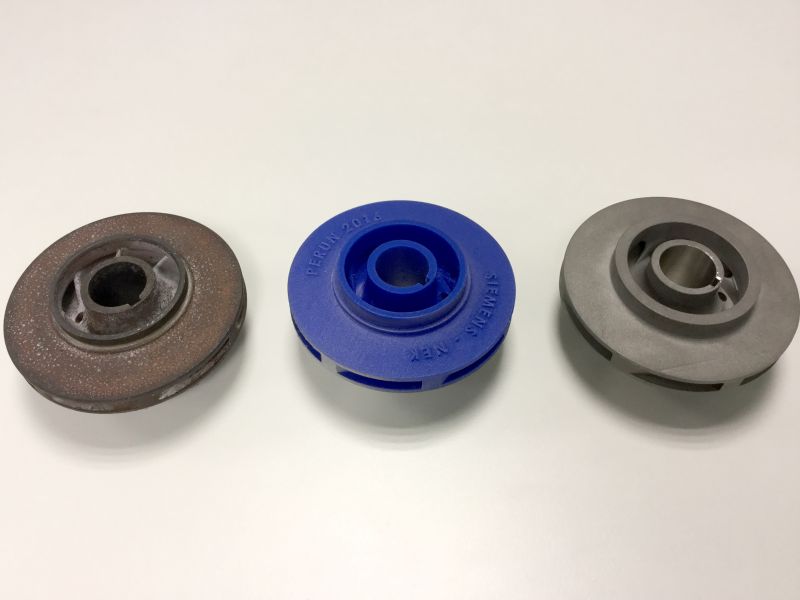ORLANDO, Fla. (March 9, 2017)—Following the integration of 3D printing as part of its digital services portfolio, Siemens is touting the first successful commercial installation and continuing safe operation of a 3D-printed part in a nuclear power plant, according to a statement from the company.
The replacement part produced for the Krško nuclear power plant in Slovenia is a metallic, 108-millimeter diameter impeller for a fire protection pump that is in constant rotating operation. The water pump provides pressure for the fire protection system at the plant.
 This photo shows the original, obsolete water impeller (left), Siemens’ 3D-printed prototype (middle) and the resulting 3D-printed replacement (right) installed and operating in Krško NPP in Slovenia. (Courtesy of Siemens)
This photo shows the original, obsolete water impeller (left), Siemens’ 3D-printed prototype (middle) and the resulting 3D-printed replacement (right) installed and operating in Krško NPP in Slovenia. (Courtesy of Siemens)The original impeller was in operation since the plant was commissioned in 1981; its original manufacturer is no longer in business. Obsolete, non-OEM parts are particularly well-suited for this new technology as they and their designs are virtually impossible to obtain, Siemens said in the statement. This technology allows mature operating plants to continue operating and achieving or, as in the Krško case, even extending, their full life expectancy.
Siemens’ team of experts in Slovenia reverse-engineered and created a “digital twin” of the part. The company’s additive manufacturing (AM) facility in Finspång, Sweden, then applied its advanced AM process using a 3D printer to produce the part.
“We continue to push forward our investments and cutting-edge advancements in additive manufacturing and 3D printing,” said Tim Holt, CEO of Siemens Power Generation Services division. “This achievement at the Krško nuclear power plant is another example of how the digital transformation and the data-driven capabilities we have are impacting the energy industry in ways that really matter. Additive manufacturing's reduced lead times and faster production optimizes parts replacement and creates real value for our customers.”
Meeting the Krško NPP's stringent quality and safety assurance requirements required extensive testing that was performed jointly with the Krško operations team over several months, ensuring that the new 3D-printed part would perform safely and reliably. Further material testing at an independent institute as well as a CT scan, showed that the material properties of the 3D-printed part were superior to those of the original part.
“The better-than-expected performance of this 3D-printed part gave us confidence that we can reach the full life expectancy from our asset,” said Vinko Planinc, head of maintenance at the Krško plant. “Siemens has a long history of innovation in this area and their dedication to providing their customers with the latest, proven innovations made them an excellent partner for this project.”
Siemens and Krško plan to continue research and development in this area and are looking at advancing the design of parts that are most difficult to produce using classical manufacturing techniques, such as lightweight structures with improved cooling pattern, according to the statement.


